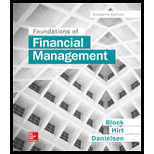
Concept explainers
a.
To determine: The effect of EPS with each plan taking in consideration both the current plan and two other plans of Dickinson company.
Introduction:
Earning per share (EPS):
It is the profit per outstanding share of a public company. A higher EPS indicates higher value of the company because investors are ready to pay higher price for one share of the company.Â
b.
To determine: The most favourable plan, if ROA falls to 5% and rises to 15% (considering all the plans) for Dickinson company.
Introduction:
It is the financial ratio that shows the profitability of the firm in relation to the usage of resources and can be calculated by dividing the net income to the total assets of the firm.
Earning per share (EPS):
It is the profit per outstanding share of a public company. A higher EPS indicates higher value of the company because investors are ready to pay higher price for one share of the company.
c.
To explain: The most favorable plan before restructuring activity if common stock increases to 12 dollars for Dickinson company.
Introduction:
Earning per share (EPS):
It is the profit per outstanding share of a public company. A higher EPS indicates higher value of the company because investors are ready to pay higher price for one share of the company.
Want to see the full answer?
Check out a sample textbook solution
Chapter 5 Solutions
Foundations of Financial Management
- Beta Company Ltd issued 10% perpetual debt of Rs. 1,00,000. The company's tax rate is 50%. Determine the cost of capital (before tax as well as after tax) assuming the debt is issued at 10 percent premium. helparrow_forwardFinance subject qn solve.arrow_forwardPlease help with questionsarrow_forward
 EBK CONTEMPORARY FINANCIAL MANAGEMENTFinanceISBN:9781337514835Author:MOYERPublisher:CENGAGE LEARNING - CONSIGNMENT
EBK CONTEMPORARY FINANCIAL MANAGEMENTFinanceISBN:9781337514835Author:MOYERPublisher:CENGAGE LEARNING - CONSIGNMENT
